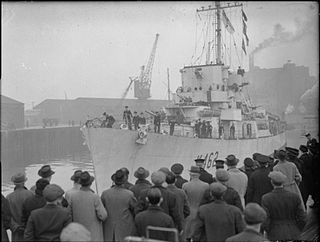
HMS Balfour was a Captain-class frigate of the Royal Navy which served during World War II. She was built as a TE (Buckley) type destroyer escort in the United States and delivered to the Royal Navy under the Lend-Lease arrangement.

HMS Affleck was a Captain-class frigate which served during World War II. The ship was named after Sir Edmund Affleck, commander of HMS Bedford at the Moonlight Battle in 1780 during the American Revolutionary War.
USS Fleming has been the name of more than one United States Navy ship, and may refer to:
HMS Pasley (K564), ex-Lindsay, was a Captain-class frigate of the Evarts-class of destroyer escort, originally commissioned to be built for the United States Navy. Before she was finished in 1943, she was transferred to the Royal Navy under the terms of Lend-Lease, and saw service during the World War II from 1943 to 1945. She was the third ship of the Royal Navy to be named Pasley, after Admiral Sir Thomas Pasley (1734-1808), who commanded aboard his flagship HMS Bellerophon at the Glorious First of June in 1794.
HMS Duff (K352) was a British Captain-class frigate of the Royal Navy that served during World War II. Originally constructed as the United States Navy Buckley class destroyer escort USS Lamons (DE-64), she was transferred to the Royal Navy before she was completed.

HMS Ekins (K552) was a British Captain-class frigate of the Royal Navy that served during World War II. Originally constructed as a United States Navy Buckley class destroyer escort, she served in the Royal Navy from 1943 to 1945.

The second HMS Fitzroy (K553) was a British Captain-class frigate of the Royal Navy in commission during World War II. Originally constructed as a United States Navy Buckley class destroyer escort, she served in the Royal Navy from 1943 to 1945.
The second HMS Redmill (K554), and first ship to see service under the name, was a British Captain-class frigate of the Royal Navy in commission during World War II. Originally constructed as a United States Navy Buckley class destroyer escort, she served in the Royal Navy from 1943 to 1945.
HMS Rowley was a British Captain-class frigate of the Royal Navy in commission during World War II. Originally constructed as a United States Navy Buckley class destroyer escort, she served in the Royal Navy from 1943 to 1945.
HMS Tyler (K576) was a British Captain-class frigate of the Royal Navy in commission during World War II. Originally constructed as a United States Navy Buckley-class destroyer escort, she served in the Royal Navy from 1944 to 1945.
HMS Cooke (K471) was a British Captain-class frigate of the Royal Navy in commission during World War II. Originally constructed as the United States Navy Evarts-class destroyer escort USS Dempsey (DE-267), she served in the Royal Navy from 1943 to 1946.
HMS Domett (K473) was a British Captain-class frigate of the Royal Navy in commission during World War II. Originally constructed as the United States Navy Evarts-class destroyer escort USS Eisner (DE-269), she served in the Royal Navy from 1943 to 1946.

The second HMS Foley (K474) was a British Captain-class frigate of the Royal Navy in commission during World War II. Originally constructed as the United States Navy Evarts-class destroyer escort USS Gillette (DE-270), she served in the Royal Navy from 1943 to 1945 and in the U.S. Navy as USS Foley (DE-270) from August to October 1945.
HMS Gardiner (K478) was a British Captain-class frigate of the Royal Navy in commission during World War II. Originally constructed as the United States Navy Evarts-class destroyer escort USS O'Toole (DE-274), she served in the Royal Navy from 1943 to 1946.

HMS Gore (K481) was a British Captain-class frigate of the Royal Navy in commission during World War II. Originally constructed as the United States Navy Evarts-class destroyer escort USS Herzog (DE-277), she served in the Royal Navy from 1943 to 1946.
HMS Gould (K476) was a British Captain-class frigate of the Royal Navy in commission during World War II. Originally constructed as the United States Navy Evarts-class destroyer escort USS Lovering (DE-272), she served in the Royal Navy from 1943 until her sinking in 1944.

HMS Grindall (K477) was a British Captain-class frigate of the Royal Navy in commission during World War II. Originally constructed as the United States Navy Evarts-class destroyer escort USS Sanders (DE-273), she served in the Royal Navy from 1943 to 1945 and then in the U.S. Navy as USS Grindall (DE-273) from August to October 1945.
HMS Keats (K482) was a British Captain-class frigate of the Royal Navy in commission during World War II. Originally constructed as the United States Navy Evarts-class destroyer escort USS Tisdale (DE-278), she served in the Royal Navy from 1943 to 1946.
HMS Kingsmill (K484) was a British Captain-class frigate of the Royal Navy in commission during World War II. Originally constructed as the United States Navy Evarts-class destroyer escort DE-280, she served in the Royal Navy from 1943 to 1945 and then in the U.S. Navy as USS Kingsmill (DE-280) from August to October 1945.
The second HMS Manners (K568) was a British Captain-class frigate of the Royal Navy in commission during World War II. Originally constructed as the United States Navy Evarts-class destroyer escort DE-523, she served in the Royal Navy from 1943 to 1945.






